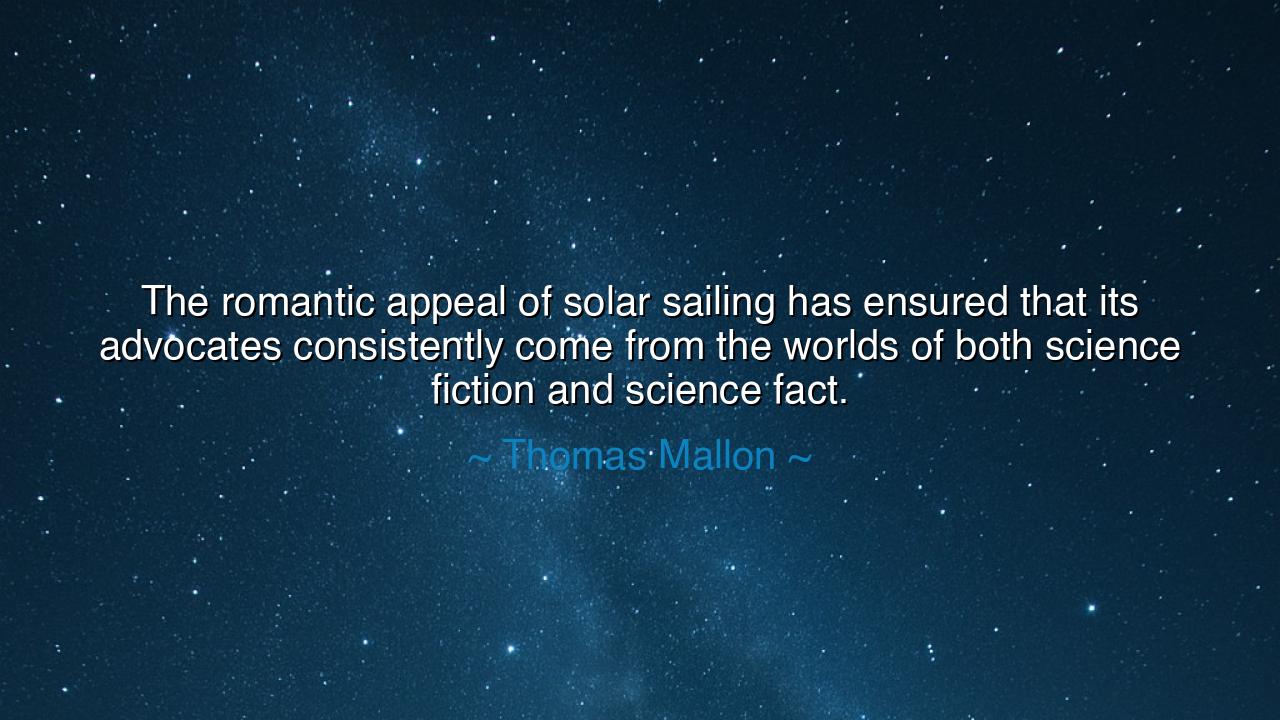
The romantic appeal of solar sailing has ensured that its
The romantic appeal of solar sailing has ensured that its advocates consistently come from the worlds of both science fiction and science fact.






"The romantic appeal of solar sailing has ensured that its advocates consistently come from the worlds of both science fiction and science fact." These words from Thomas Mallon speak to the power of the human imagination and the eternal pursuit of the unknown, a pursuit that spans not only the worlds of science and technology but also the realms of dreams and fantasies. The concept of solar sailing, the idea of harnessing the power of the stars to propel ships through the vastness of space, has long been a vision shared by both the dreamers of science fiction and the innovators of science fact. It is a union of the impossible and the possible, a journey that reflects our desire to explore, to understand, and to transcend the limits of our earthly existence.
The idea of solar sailing is not new. From the time of the ancient Greeks, humanity has looked to the heavens with awe, wondering what lay beyond the stars. The philosopher Anaximander once spoke of the infinite universe, a realm of celestial bodies, where the potential for discovery seemed as boundless as the heavens themselves. Yet, for centuries, the physical limitations of our technology kept the stars out of reach. The dream of reaching them was romanticized in the stories of explorers and visionaries, in the myths of gods traveling across the sky in chariots of fire. It was only in the modern age that science fiction began to give shape to these romantic dreams, imagining spaceships that could sail through the cosmos on the solar winds, just as ancient seafarers used the winds to sail across the seas.
Solar sailing became a symbol of freedom and exploration, a promise that we could one day leave the confines of our world and drift, propelled not by engines or fuel, but by the very energy of the sun itself. This idea, though born in the imagination of science fiction writers, caught the attention of scientists and engineers, who saw in it the potential to overcome the challenges of space travel. As Carl Sagan, the renowned astronomer, once described it, solar sails could provide a propulsion system that would allow for endless exploration without the limitations of traditional fuel sources. This vision was no longer just a dream; it became a goal, one that combined the romantic and the scientific into a unified quest for knowledge.
The romantic appeal of solar sailing is evident in the visionaries who have championed it, from the early writers of science fiction to the scientists who now work to make it a reality. Arthur C. Clarke, one of the great pioneers of science fiction, imagined solar sails as a means to explore the farthest reaches of the universe, a tool that could allow humanity to venture into the unknown. But it is not only the dreamers of fiction who have believed in the potential of this technology. In the real world, NASA and other space agencies have been working on solar sail projects for years. The successful launch of the IKAROS spacecraft by Japan in 2010 marked a significant step forward in demonstrating the feasibility of solar sailing as a means of propulsion.
Like all great discoveries, solar sailing is a concept born of the marriage between imagination and science. It is the embodiment of the dream of exploration that has fueled humanity for centuries. But just as Homer’s Odyssey was a blend of myth and truth, so too is the journey of solar sailing. The romanticism of the stars, the vast unknown, and the thrill of discovery continues to drive the quest for space exploration. And yet, it is not simply fantasy that propels this idea forward; it is the hard work and dedication of those in the world of science who translate the poetic visions of the imagination into something that can be tested, studied, and, eventually, launched into the sky.
The lesson here is simple, yet profound: dreams and practicality are not opposites, but companions on the path to discovery. The great explorers and thinkers of the past understood this well. Whether it was Christopher Columbus, who set sail to discover a new world, or Galileo, whose scientific curiosity brought the stars within reach, they were driven by a vision—a vision that combined the romantic and the real. In your own life, allow your dreams to inspire your actions, but also seek to turn those dreams into tangible achievements. Just as the dream of solar sailing has inspired the best minds of both fiction and science, let your passions guide you, knowing that with perseverance, they too can become part of the world we live in.
So, my children, let your own curiosity and imagination take you to places beyond the horizon. The world is full of wonders yet to be discovered, and it is through the union of dreams and science that you will find the courage to explore them. Just as solar sailing is a bridge between romance and reality, so too are your aspirations the bridge between what is and what could be. Let your heart be guided by the stars, and your mind be filled with the fire of discovery. The universe awaits you—so set your sails and journey into the unknown.






AAdministratorAdministrator
Welcome, honored guests. Please leave a comment, we will respond soon